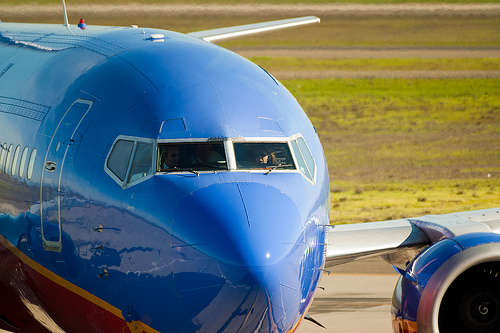Commercial Airline Pilot Job Description

© 2012 by Aurelio Locsin.
The primary responsibility of commercial airline pilots is to see to the safety of their passenger and crew, which may occasionally prevent them from flying their planes, especially under adverse whether conditions. The vehicles they handle are highly complex machines that can affect the lives of those in the air and on the ground. They thus demand specific qualifications for quality job performance.
Duties
Commercial airline pilots fly airplanes that carry passengers while following a fixed schedule and route that spans the United States of the world. Their shifts are highly irregular, covering an average of 75 hours per month in the air and 150 hours per month in non-flight duties such as writing reports and training. They often spend up to three days a week away from home, but receive accommodations, food and ground transportation from their employers as part of the layover. The number of years on the job determines working hours and routes. Federal law mandates retirement at age 65 because the job can be physically and mentally taxing.
Qualifications
To become a commercial airline pilots requires training from a facility or instructor approved by the Federal Aviation Administration, although many also learn their skills from the military. Airline companies demand the passing of aptitude and psychological tests, and at least two years of college for applicants, so most pilots have bachelor’s degrees. Pilots need a commercial license for transporting passengers, an instrument rating to fly during when visibility is low and airline certification. They may start their careers with charter planes or crop dusters, then work for small airlines or corporations, and then become first officers with major airlines. After many years of experience, they may then advance to become captains.
Wages
The Bureau of Labor Statistics state that airline pilots earned a mean annual $118,070, as of May 2011, with lows under $57,420 yearly, and highs above an annual $187,199. Airline Pilot Central shows how pay for a single airline can change according to type of aircraft and experience. As of 2012, hourly pay rates for captains at United Airlines ran $137 for those in charge of A320s and B737s, $159 for B767s and B757s and $190 for B747s and B777s. For experience, hourly rates for captains started at $177 in the first year, became $182 in the fifth year and jumped to $190 in the 12th year.
Outlook
Although a growing population will increase the use of air travel from 2010 to 2020, jobs for airline pilots are expected to increase by only 6 percent, which is less than the 14 percent predicted for all jobs in all professions, and less than a third the projected growth of 21 percent for all commercial pilots. Consolidation in the industry will reduce job opportunities. Competition will be strong, with many more applicants than openings. Those with previous experience with military, cargo companies or regional airlines will have the best chances with major airlines.
Related Links
- U.S. Bureau of Labor Statistics
The Bureau of Labor Statistics is the principal fact-finding agency for the Federal Government in the broad field of labor economics and statistics. - Alocsin's Jobs and Salaries Index
The following is an index to Alocsin's hubs on jobs, employment and salaries, arranged in alphabetical order by category and then title. The last section, What's New, lists the five newst jobs hubs. - Alocsin's Railroad Jobs and Salaries Index
The following is an index to Alocsin's hubs on railroad jobs and salaries, include locomotive engineers, train conductors and brakemen. The hubs are arranged in alphabetical order by title. - Alocsin's Computer Jobs and Salaries Index
The following is an index to Alocsin's hubs on computer jobs and salaries, sorted alphabetically by title. Click any link to visit its associated hub. Feel free to add any constructive criticism in the Comment field at the end of this index.









